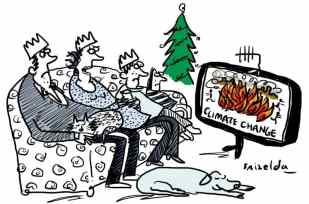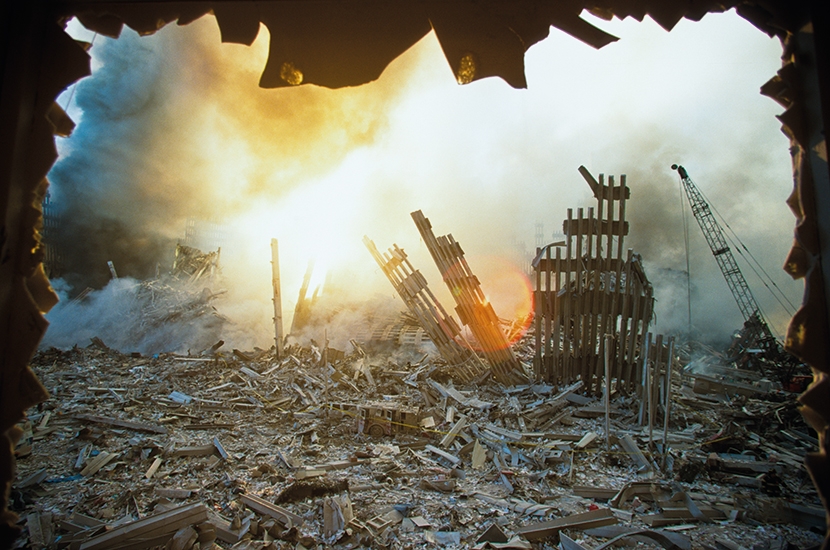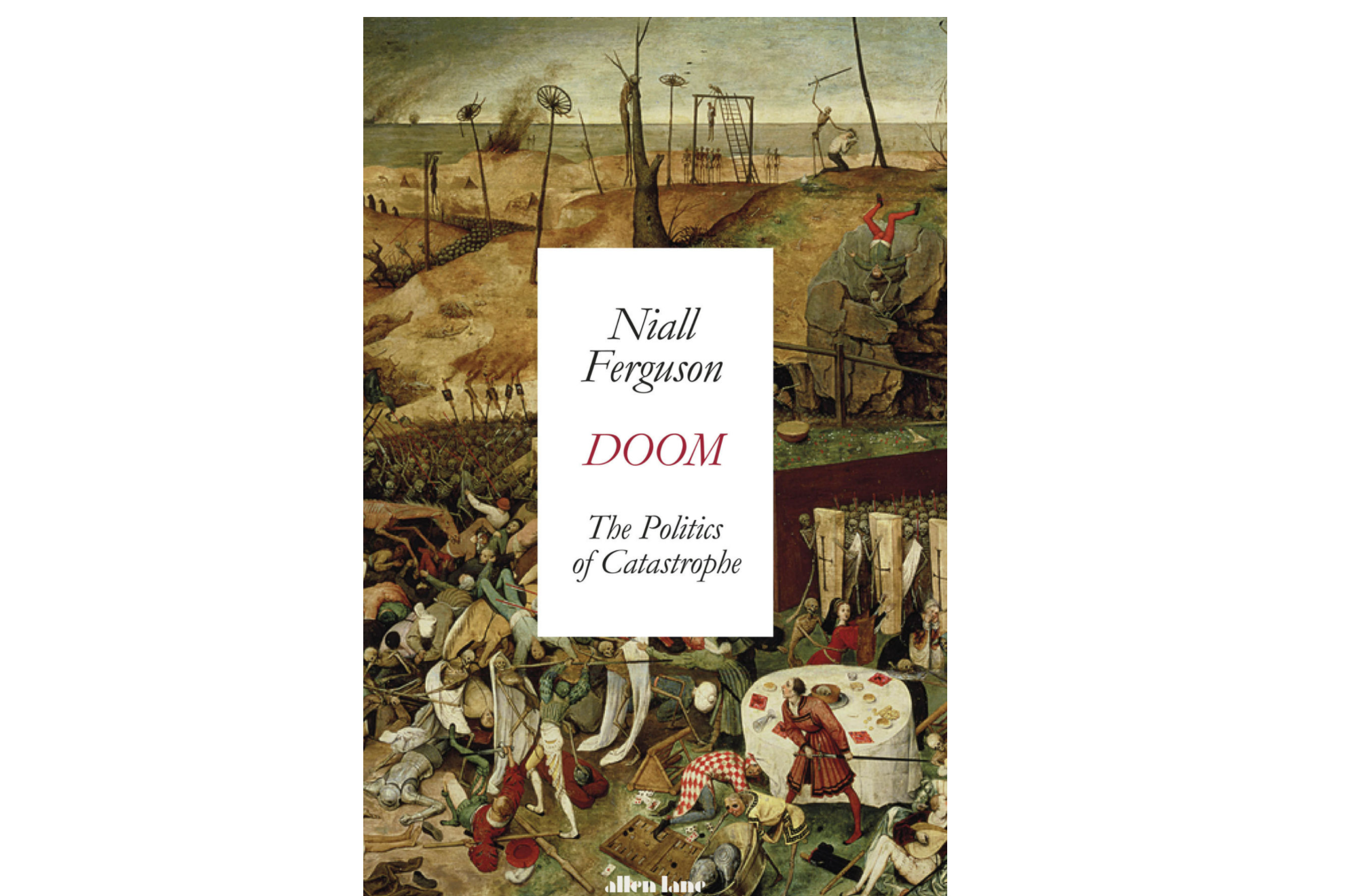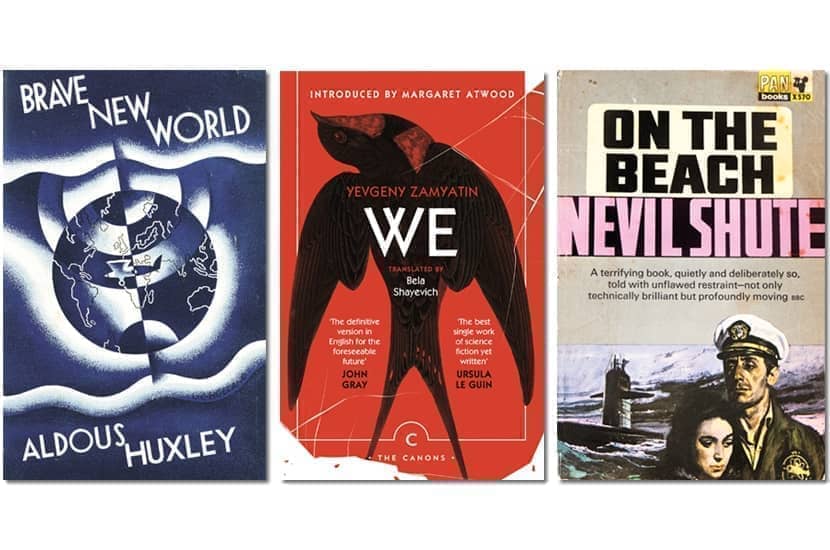The pandemic is not quite over, but we are getting used to its inconveniences. What disaster will be next? An antibiotic-resistant strain of the bubonic plague? Climate collapse? Coronal mass ejection? Will the next catastrophe be natural — perhaps a massive volcanic eruption, the likes of which we have not seen for more than two centuries, since Tambora in 1815? Or will it be a man-made calamity — nuclear war or a cyberattack? And might we inadvertently descend into a new form of AI-enabled totalitarianism in our efforts to ward off such calamities?
To all these potential disasters it is impossible to attach more than made-up probabilities. So what can we do about them? The best answer would be that we should strive to imagine them. For the past two centuries, this has been the role of science fiction. Dystopias are histories of the future. This sounds like a contradiction in terms, but as they have always echoed present fears (or, to be more precise, the anxieties of the literary elite), they show us which worries of the past had a role in history. As Fahrenheit 451 author Ray Bradbury once said: ‘I am a preventer of futures, not a predictor of them.’ But how many policy decisions have been influenced by dystopian visions? And how often did these turn out to be wise ones?
The 1930s policy of appeasement, for example, was based partly on an exaggerated fear that the Luftwaffe could match H.G. Wells’s Martians in destroying London. More often, though, nightmarish visions have failed to persuade policymakers to act. Yet science fiction has been a source of inspiration, too. When Silicon Valley began thinking about how to use the internet, they turned to writers such as William Gibson and Neal Stephenson. Today, no discussion of artificial intelligence is complete without reference to 2001: A Space Odyssey, just as nearly all conversations about robotics include a mention of Philip K. Dick’s Do Androids Dream of Electric Sheep? or the movie it inspired, Blade Runner.
Now that the long-feared pandemic has arrived — along with rising sea levels, virtual reality, prototypes of flying cars, and levels of state surveillance undreamt of by George Orwell — we can turn back to science fiction and ask: who got the future most right? For the truth is that dystopia is now, not in some future date. The history of the future deserves our attention, partly because it may help us to think more rigorously about the shape of the next things to come. Historical data remains the foundation for all kinds of forecasting. Models based on theory may work, but without past statistics we cannot verify them. Yet future technological changes are not easy to infer from the past. Science fiction provides us with a large sample of imagined discontinuities that might not occur if we only looked backwards.
Mary Shelley is best known for Frankenstein (1818), but The Last Man (1826) was equally revolutionary. With its vision of mass extinction following a plague and a depopulated world, it was the first truly dystopian novel. By the 1890s, dystopia was a popular genre, thanks to H.G. Wells. In The War of the Worlds (1898), the Martians annihilate Londoners with weaponry reminiscent of the intra-terrestrial world wars that lay ahead. Humanity is saved by a pathogen against which the invaders have no immunity.
In our time, anxieties about man-made climate change have made environmental disaster a subject for dystopian fiction. Works like Margaret Atwood’s Oryx and Crake (2003), Cormac McCarthy’s The Road (2006) and Paolo Bacigalupi’s The Windup Girl (2009) project humanity’s worst fears with apocalyptic dread.

Novels about the planet turning against us have their precursors. During the Cold War, visions of climatic disaster drove the anti-nuclear and environmental movements. In Nevil Shute’s On the Beach (1957), people face the slowly spreading fallout from nuclear war. In J.G. Ballard’s The Drowned World (1962), rising temperatures (owing to solar activity, not pollution) submerge cities.
Finally, there are dystopias inspired by mass migration. In Michel Houellebecq’s Submission (2015), the French left sides with an Islamic fundamentalist party rather than help the right-wing Front National take power. The new government purges non-Muslims from state and academic positions, legalises polygamy, and distributes attractive wives. The novel ends with the protagonist submitting to the new order. Although Houellebecq was widely accused of Islamophobia at the time of its publication, the book is a satire of France’s fragile institutions and of the urban intellectuals’ failure to defend them.
The West today seems more Huxley than Orwell: a world of corporate distraction more than state brutality
As Submission shows, science fiction is as much concerned with political catastrophe as with natural and technological disasters. A recurrent dystopia since the 1930s has been a fascist America. This fear has persisted, from Sinclair Lewis’s It Can’t Happen Here (1935) to Margaret Atwood’s The Handmaid’s Tale (1985), Philip Roth’s The Plot Against America (2004) and Suzanne Collins’s The Hunger Games (2008). The nightmare here is Stalin-like totalitarianism. Fahrenheit 451 (published in 1953 but set in 1999) describes an illiberal America where books are banned and the job of firemen is to burn them. (Though the novel is sometimes interpreted as a critique of McCarthyism, Bradbury’s real message was that the preference of ordinary people for the vacuous entertainment of TV and the willingness of religious minorities to demand censorship together posed a creeping threat to the book as a form for serious content.) But of all these dystopian visions, none has surpassed Orwell’s Nineteen Eighty-Four (1949).
In a remarkable letter written in October 1949, Aldous Huxley — who had been Orwell’s French teacher at Eton — warned him that he was capturing his own present rather than the likely future. ‘The philosophy of the ruling minority in Nineteen Eighty-Four,’ Huxley wrote, ‘is a sadism which has been carried to its logical conclusion… Whether in actual fact the policy of the boot-on-the-face can go on indefinitely seems doubtful. My own belief is that the ruling oligarchy will find less arduous and wasteful ways of governing and of satisfying its lust for power, and these ways will resemble those which I described in Brave New World’. Huxley’s Brave New World (1932) is a very different dystopia. Citizens submit to a caste system, conditioned to be content with physical pleasure. Self-medication (‘soma’), constant entertainment (the ‘feelies’), regular holidays and ubiquitous sexual titillation are the basis for mass compliance. Censorship and propaganda play a part, but overt coercion is rarely visible. The West today seems more Huxley than Orwell: a world more of corporate distraction than state brutality.
Yet none of these authors truly foresaw our networked world, which has combined the rising technological acceleration with a slackening of progress in other areas, such as nuclear energy, and a degeneration of governance. The real prophets are less known figures, like John Brunner, whose Stand on Zanzibar (1968) is set at a time — 2010 — when population pressure has caused social division and political extremism. Despite the threat of terrorism, US corporations are booming, thanks to a supercomputer. China is America’s new rival. Europe has united. Brunner envisaged affirmative action, genetic engineering, Viagra, Detroit’s collapse, satellite TV, in-flight video, gay marriage, laser printing, electric cars, the decriminalisation of marijuana and the decline of tobacco. There’s even a progressive president (albeit of the Africa state of Beninia, not America) named ‘Obomi’.
With comparable prescience, William Gibson’s Neuromancer (1984) anticipates the world wide web and AI. Opening in the dystopian Japanese underworld of Chiba City, it imagines a global computer network in cyberspace called the ‘matrix’. Neal Stephenson’s Snow Crash (1992), which was especially popular among Facebook employees in the company’s early years, foresaw corporate overreach and virtual reality in an almost anarchic America. The state has withered away in California; everything has been privatised. Most people spend half their time in virtual reality, where their avatars have more fun than they themselves do in the real world. Meanwhile, flotillas of refugees approach via the Pacific. These cyberpunk Americas are much closer to the US in 2021 than the fascist dystopias of Lewis, Atwood or Roth.
Similarly, the most famous prophets of surveillance states — Orwell and Huxley — have been outflanked when it comes to making sense of today’s totalitarian countries. Take China, which better resembles Yevgeny Zamyatin’s We: a book written in 1921, but suppressed by the Bolsheviks. It is set in a future ‘One State’ led by ‘the Benefactor’, where the ‘ciphers’ — who have numbers, not names, and wear standardised ‘unifs’ — are under constant surveillance. All apartments are made of glass, with curtains that can be drawn only when one is having state-licensed sex. Faced with insurrection, the omnipotent Benefactor orders the mass lobotomisation of ciphers, as the only way to preserve universal happiness is to abolish the imagination.

Then there is Chan Koonchung’s The Fat Years (2009) — which is banned in China. In this story, tap water is laced with drugs that render people docile, but at a cost. The month of February 2011 has been removed from public records and popular memory. This was when drastic emergency measures were introduced to stabilise the Chinese economy and assert China’s primacy in east Asia. Chan is one of a number of recent Chinese authors who have envisioned the decline of America, the corollary of China’s rise. The Fat Years is set in an imagined 2013, after a second western financial crisis makes China the world’s no. 1 economy. In Han Song’s 2066: Red Star over America (2000), a terrorist attack destroys the World Trade Center and the rising ocean sweeps over Manhattan. And in Liu Cixin’s The Three-Body Problem (2006), a Chinese nanotechnology expert and a Beijing cop lead the global defence against an alien invasion that’s the fault of a misanthropic Chinese physicist.
Yet even mainland-based Chinese authors are conscious of the country’s deeply illiberal nature and recurrent instability. The ‘problem’ of The Three-Body Problem is a virtual-reality game, set in Trisolaris, a distant world with three suns rather than one. The gravitational attractions of the suns prevent this planet from settling into an orbit with regular days, nights and seasons. It has occasional ‘Stable Eras’, during which civilisation can advance but, with minimal warning, these give way to ‘Chaotic Eras’ of intense heat or cold that render it uninhabitable. The central conceit of Liu’s novel is that China’s history has the same pattern as the three-body problem: periods of stability always end with periods of chaos. The three bodies in contention are not suns but classes: rulers, intellectuals, masses. The Tri-solarans, like good totalitarians, are omniscient. Their invisible ‘sophons’ provide them with complete surveillance of humanity, enabling them to prevent further scientific progress on Earth. But these approaching invaders turn out to have a weakness. Their culture of complete transparency — communication via unfiltered thought — precludes cheating or lying, so they cannot ‘pursue complicated strategic thinking’.
Is it too much to see here an allegory of China’s changing place in the world — perhaps even of the new cold war between America and the People’s Republic? If not, it is an unnerving allegory — an enthralling intimation of a future geopolitical disaster.
If, as Paul Samuelson joked, declines in US stock prices have correctly predicted nine of the last five American recessions, science fiction has correctly predicted nine of the last five technological breakthroughs. Flying cars remain at the prototype stage, and time machines are nowhere to be seen. (And, of course, science fiction has predicted many more than nine of the last ends of the world.) Nevertheless, the genre can play an important role in helping us think clearly about the future. One reason that I was quicker than most to see that a pandemic had begun in January 2020 was because I spent 2019 reading the books referred to here. I cannot guarantee reading the new Neal Stephenson, Termination Shock, will necessarily prepare you for the next metaverse. But there are worse places to begin preparing for the next disaster.
NOTE FROM FRASER NELSON, EDITOR:-
A longer version of this argument – and many more – can be found in Niall Ferguson’s 2021 book, Doom: the Politics of Catastrophe, which I reviewed here and you can buy here. It’s the best book you’ll read about Covid-19, the issues it raises and how it challenges how we understand the post-pandemic world.








Comments